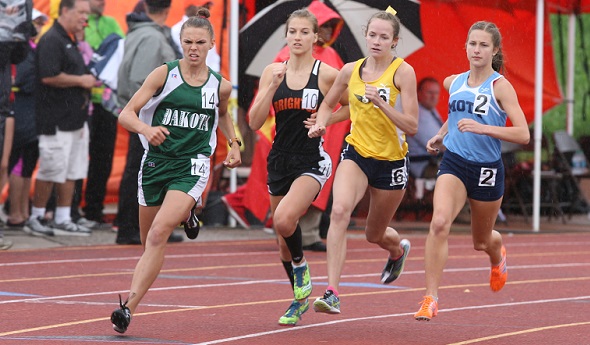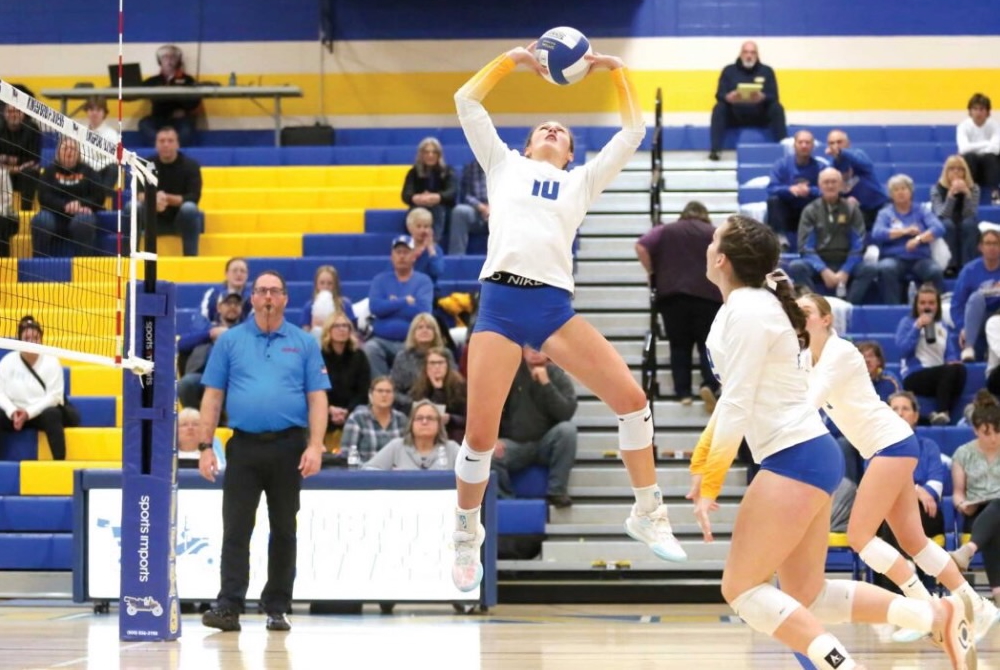
Health Challenges Can't Ground Dobies
By
Tom Markowski
Special for Second Half
May 18, 2016
MACOMB TOWNSHIP – Look at Kayla Dobies and one can see a vibrant young woman with an engaging personality that locks on to those around her.
 Look at Dobies’ accomplishments, athletically and academically, and one will marvel at her ingenuity and perseverance.
Look at Dobies’ accomplishments, athletically and academically, and one will marvel at her ingenuity and perseverance.
Hidden are ailments that would prevent a lesser person from achievements that flow from Dobies in a variety of forms.
Dobies, 18, is a senior at Macomb Dakota and has been accepted to Princeton University. In addition to her studies, Dobies plans on competing collegiately in cross country and track and field. The high jump is her best event – her best is a jump of 5 feet, 7 inches. But she is also a fine distance runner. Dobies placed eighth in Lower Peninsula Division 1 her freshman season in the high jump and was all-state again her junior season as she placed fourth in the 800-meter run.
Her best cross country time is 18:27, a school record. She qualified for the MHSAA Finals in cross country her junior and senior seasons but failed to place. The reasons will become obvious later.
For six years she practiced taekwondo and holds a first and second degree black belt in the sport.
As a junior she started a robotics team at Dakota, but did not compete. Although Dakota did not fare well in the state competition this year, the team competed at the world championships, a four-day event held in late April, in St. Louis, and won. The name of the team is the Thunder Chickens, and among Dobies’ responsibilities was as an assistant mechanic. When one of the machines broke down, she would assist in fixing it, thus earning the nickname, ‘Baby Chicken’.
Dobies has a 4.07 grade-point average entering her final semester and scored a 33 on her ACT. She was named a winner this winter of the MHSAA/Farm Bureau Insurance Scholar-Athlete Award and was one of six finalists for the recently-awarded Detroit Athletic Club Female High School Athlete of the Year.
She plans on entering the pre-med program at Princeton and possibly majoring in neuroscience.
As impressive as is her list of accomplishments, Dobies often has had to miss competing because of her illnesses. Every day Dobies confronts them. She tries to hold them off with daily medication, and sometimes even that doesn’t work.
Topping this list, Dobies is an asthmatic. Offshoots are the allergies from which she suffers. She’s also anemic and suffers from hypoglycemia, a blood sugar disorder. She can’t eat candy. She can only consume pure sugar. And she can’t eat fast food or pizza, or other like fatty foods because of their trans-fatty acids.
It’s the pizza part that upsets Dobies most, even as that seems like one of the lesser obstacles she continuously must hurdle.
“I have every type of asthma you can imagine,” she said. “I use a breathing machine at night and two inhalers every day. I get allergy shots. I’m allergic to mites. I have to have special sheets on my bed to help prevent an attack.”
The attacks continue to occur. The reason she did not compete in robotics her junior year was her health. Most days, Dobies is fine. The medication she takes helps combat her diseases, but it’s not foolproof. When the seasons change, Dobies suffers most.
A leg injury kept Dobies from possibly making all-state in cross country her junior year, and this past November she suffered an asthma attack at the MHSAA Finals. Though cross country and running in general is one of her favorite sports, fall changing to winter is the worst season for Dobies.
“When others are improving their times, my times get worse,” she said. “I was in the hospital a couple of days during the cross country season. When I have an asthma attack, it’s not fun.”
Because of her condition, Dobies prefers to run in warm weather – the hotter the better. That’s why she’s hoping for warm weather, at least warmer weather, Saturday when Dakota competes at the Division 1 Track & Field regional at Warren Mott.
 The spring didn't start well for Dobies. She suffered a pulled quadriceps (right leg) in the first meet of the season, and it wasn’t until three weeks ago that she could run the way she knows she can.
The spring didn't start well for Dobies. She suffered a pulled quadriceps (right leg) in the first meet of the season, and it wasn’t until three weeks ago that she could run the way she knows she can.
“I’m better now,” she said. “I’ve just got to get my times to drop.”
No one will doubt that she will. Dobies has always been highly motivated. This comes from her parents, Jeff and Jody Dobies, and she’s received a push from others including Dakota assistant track coach Tom Zarzycki. Jeff Dobies introduced his eldest daughter to soccer when she was 2 years old, and sports has been a big part of her life ever since.
“I watched the Olympics at Beijing and I saw the high jump,” she said. “I said, I can do that. So I asked my dad, what’s that? And he told me it was the high jump.”
Ever the inquisitive child, Dobies was inspired after viewing the Disney animated film “Mulan” to try martial arts.
“I’ve always liked sports,” she said. “I’m really, really passionate about everything. Take robotics and martial arts. I figure if you’re going to do something, do your best.
“Like running. I love to run. High jump is the reason I got into running. It gets down to a deep level. I just love running. I love running with my friends. I love running to compete.”
Whatever the task, whatever the challenge, anything Dobies dives into she gives it her best.
Her most recent project is experimenting with rats. It’s a class project, one she must complete to earn a grade. What she’s attempting to prove, with the aid of the rats, is that fear is innate.
“I’m still working on it,” she said. “I don’t expect to change the world.”
But she might.
 Tom Markowski is a columnist and directs website coverage for the State Champs! Sports Network. He previously covered primarily high school sports for the The Detroit News from 1984-2014, focusing on the Detroit area and contributing to statewide coverage of football and basketball. Contact him at [email protected] with story ideas for Oakland, Macomb and Wayne counties.
Tom Markowski is a columnist and directs website coverage for the State Champs! Sports Network. He previously covered primarily high school sports for the The Detroit News from 1984-2014, focusing on the Detroit area and contributing to statewide coverage of football and basketball. Contact him at [email protected] with story ideas for Oakland, Macomb and Wayne counties.
PHOTOS: (Top) Macomb Dakota's Kayla Dobies (14) rounds the bend ahead of three competitors during the 800 at last season's Lower Peninsula Division 1 Final. (Middle) Dobies stands with other Scholar-Athlete Award winners in March at the Breslin Center. (Top photo by Carter Sherline/RunMichigan.com.)

Kingsford's Kreider Prepared for Next Level After Finishing Stellar Flivvers Career
By
John Vrancic
Special for MHSAA.com
June 19, 2025
KINGSFORD — After completing a successful high school volleyball career, Maddy Kreider is ready to take the next step.
 The Kingsford senior is taking her talents to Michigan Tech, where she’s expected to continue primarily as a setter.
The Kingsford senior is taking her talents to Michigan Tech, where she’s expected to continue primarily as a setter.
“That will be a big step for sure, but it’ll be exciting being with the girls,” she said. “The girls are taller in college. It will definitely be an adjustment, physically and mentally. We’ll be traveling longer distances, and it’ll be a matter of improving the mental part of my game.”
Kreider was selected the Upper Peninsula’s Defensive Player of the Year her final two seasons after the U.P. Sportswriters and Sportscasters Association began voting for all-U.P. volleyball.
“That’s quite an accomplishment,” she said. “It’s a real honor playing with girls I grew up with. We had a great season.”
The 5-foot-8 setter was a four-year starter and two-year team captain at Kingsford, leading the Flivvers to three Division 2 District titles and back-to-back undefeated Great Northern Conference championships. She twice was named GNC Player of the Year.
She was also selected all-state first team in the fall and all-state second team in 2023, and all-region throughout her prep career. Her serving percentage also topped .900 throughout her four seasons on varsity.
 Last fall, the Flivvers reached the Regional Semifinal at Manistique where they dropped a 3-2 decision to Kingsley.
Last fall, the Flivvers reached the Regional Semifinal at Manistique where they dropped a 3-2 decision to Kingsley.
“I thought we’d get through,” Kreider said. “We came out lights out in the first two sets, then it was close in the last three.”
Also among the team’s highlights this past fall was a victory at Calumet, approximately 2½ weeks after dropping a 3-1 decision to the Copper Kings on Kingsford’s home floor.
“We wanted to play them,” Kreider said. “They’re a great bunch of girls to play against. They’ve been the measuring stick up here for many years. Winning on their floor was super exciting. We knew we had to play well just to be competitive. That was a great confidence builder for our group. We were definitely on a high going into the District.”
The Flivvers opened their postseason with a 3-1 triumph over Houghton, then defeated Escanaba in straight sets in the District Final.
Kreider will join Calumet senior Maddie Torola at MTU this fall. Torola, who recorded a season-high 19 kills in the four-set victory at Kingsford, helped the Copper Kings finish 29-5 and reach the Division 3 Regional Final at Sault Ste. Marie where they dropped a 3-2 decision to Traverse City St. Francis.
“It was fun playing against her in high school,” Kreider said. “It will be even more fun playing as teammates. It’ll be exciting to be playing on the same team.”
Both will be playing under new head coach Cindy Pindral at Tech. Both of Kreider’s parents played for the Huskies, her mother (and Kingsford varsity coach) Jaclynn volleyball from 1998-2002 and her father Jason basketball from 1997-2000.
Maddy Kreider recently earned an additional honor when she was selected Female Athlete of the Year for Kingsford’s Class of 2025. She recently completed a solid track & field season for the Flivvers.
At the U.P. Division 1 Finals, Kreider placed fourth in the 100-meter dash (13.2) and anchored the Flivvers to a third-place finish in the 800 relay (1:51.57) and fourth in the 400 (53.03) on their home track.
Kreider was named one of 32 MHSAA/Farm Bureau Insurance Scholar-Athlete Award winners this winter and plans to study exercise science and kinesiology at MTU.
 John Vrancic has covered high school sports in the Upper Peninsula since joining the Escanaba Daily Press staff in 1985. He is known most prominently across the peninsula for his extensive coverage of cross country and track & field that frequently appears in newspapers from the Wisconsin border to Lake Huron. He received the James Trethewey Award for Distinguished Service in 2015 from the Upper Peninsula Sportswriters and Sportscasters Association.
John Vrancic has covered high school sports in the Upper Peninsula since joining the Escanaba Daily Press staff in 1985. He is known most prominently across the peninsula for his extensive coverage of cross country and track & field that frequently appears in newspapers from the Wisconsin border to Lake Huron. He received the James Trethewey Award for Distinguished Service in 2015 from the Upper Peninsula Sportswriters and Sportscasters Association.
PHOTOS (Top) Kingsford’s Maddy Kreider sets for her teammates during a match last season. (Middle) Kreider, right, takes a photo with Kingsford’s Male Athlete of the Year Gavin Grondin. (Photos provided by the Kingsford athletic department.)

